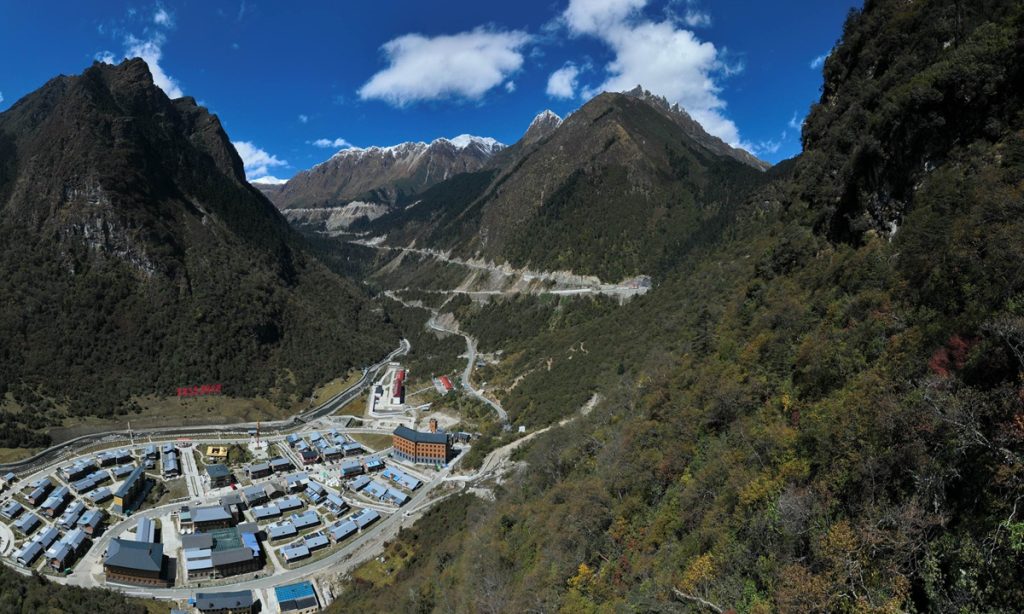Happy lives of Yumai residents show how China's border regions have dramatically developed

Yumai used to be a township with only one family of three people.
The small village in Lhunze county, Shannan Prefecture, Southwest China's Xizang Autonomous Region, used to be the smallest township population-wise in China.
Nowadays, thanks to improved transportation and infrastructure, the remote area has undergone a transformation. The streets and alleys are clean and tidy, with two-story Tibetan-style buildings that show elegance and charm at the foot of a mix of green and snow mountains.
Today, over 200 residents call this place home. They run a variety of businesses, including shops, restaurants, family inns, and teahouses. Local people wear confident and proud expressions on their faces as they warmly welcome visitors.
Yumai has become the epitome of how China's border regions have dramatically developed.
The story of Yumai begins with the family of three: Sangye Chopa, the household's father; and his daughters Drolkar and Yangzom. Sangye Chopa was the first head of the township.
In the 1950s and 1960s, Yumai, with its harsh natural conditions and extremely poor transportation, presented a formidable challenge. In 1964, Sangye Chopa, along with his wife and daughters, embarked on a challenging journey, crossing snowy mountains with a herd of cattle, to settle in Yumai.
Today, next to the Yumai township government, the Sangye Chopa Residence Memorial Hall faithfully recreates the poor living conditions of this family back in the day when they had to dry firewood in the damp and cold environment of Yumai.
Between 1964 and 1996, the Sangye Chopa family was the only household in this vast territory of Yumai. For over half a century, this father and his two daughters guarded thousands of square kilometers of the motherland. The national flag they sewed by hand flew proudly in the remote southwestern regions of China.
Yumai's development has never ceased. In 1996, the first group of resettlement families arrived in Yumai, consisting of two households made up of 11 individuals.
In 2001, before Sangye Chopa passed away, a road leading to Yumai was finally completed, ending the township's history of no road access, and the first car entered the town. In 2003, Yumai had its first telephone.
In 2017, through a reply letter, Chinese President Xi Jinping encouraged the family of Drolkar and Yangzom, to set down roots in the border area, safeguard the Chinese territory and develop their hometown. Xi hoped that the family would motivate more herders to set down roots in the border area "like galsang flowers," and become guardians of the Chinese territory and constructors of a happy hometown.
In 2019, Yumai was officially designated as a model township for achieving happiness, beauty, and a comfortable life. In April of the same year, a new group of resettlement households arrived in Yumai, increasing the population to 56 households for a total of 191 individuals. On July 3, 2020, a new road leading to Yumai was completed, putting an end to the township's history of being cut off by heavy snow for over six months of the year.
Currently, there are more than 230 people in 67 households living in Yumai township, and its infrastructure, including the electricity grid, roads, 5G network, medical care and financial services facilities, have all been improved.
The giant red slogan on the hillside that reads "Home is Yumai, country is China" is now the most famous landmark in Yumai. These were the words once spoken by Sangye Chopa, and now represents the spirit of people guarding Yumai.
"When I was young, my only playmate was my grandpa Sangye Chopa," Yangzom's son, Sonam Dondrup recalled while taking with the Global Times on Wednesday. "I never imagined life in Yumai could be like this today, nor had my grandpa."
"To me, the biggest change is school. I used to cross two mountains to go to school, which would take me three days," Sonam Dondrup said. "But now, children go to kindergarten right in our town, a couple of steps from home."
At the school in Yumai, the Global Times reporters observed several children playing on the slides and chasing each other in a warm, spacious, and brightly colored playground enclosed by glass walls. Upstairs, in a second-grade classroom with only six students, children were learning a Tibetan pop song expressing gratitude to their parents.
Pedma Tsamjo moved to Yumai in 2019. He runs a family hotel with his wife. "In border regions there are good policies for residents, that was why we moved here," in the cozy, well-decorated living room, Pedma Tsamjo told the Global Times, adding that all the subsidies combined for each adult amount to 30,000 yuan ($4,651) per year.
Pedma Tsamjo's family was sitting around the fireplace, watching martial arts dramas on a smart television, while his child slept beside them. In another year, she will also be able to attend the nearby kindergarten.
In 2022, the per capita annual income in Yumai township reached nearly 44,000 yuan, and the average living space per person was 40 square meters, the Xinhua News Agency reported.
Since 2012, border villages, townships, and counties in Xizang region have benefited from more preferential policies for infrastructure construction, covering water, electricity, roads, and housing, according to the white paper, Tibet Since 1951: Liberation, Development, and Prosperity, published by China's State Council Information Office in May 2021.